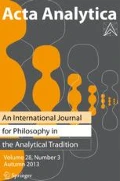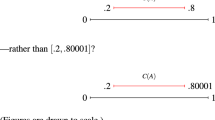Abstract
Timothy Williamson has provided damaging counterexamples to Robert Nozick’s sensitivity principle. The examples are based on Williamson’s anti-luminosity arguments, and they show how knowledge requires a margin for error that appears to be incompatible with sensitivity. I explain how Nozick can rescue sensitivity from Williamson’s counterexamples by appeal to a specific conception of the methods by which an agent forms a belief. I also defend the proposed conception of methods against Williamson’s criticisms.
Similar content being viewed by others
Notes
Nozick called this condition ‘variance’ and called variance, together with a further condition that he dubbed ‘adherence’, which I will not discuss here, ‘sensitivity’. I follow current usage, rather than Nozick’s.
Here are some others. (1) Sensitivity is incompatible with inductive knowledge (Vogel 1987; Sosa 1999). I reply in Becker (2007), chapter 3, and my “Is Sensitivity Required for Inductive Knowledge?” (manuscript submitted). (2) Sensitivity is incompatible with knowing that one knows and/or knowing that one has a true belief (Vogel 2000). I reply in Becker (2006). A version of this objection appears also in DeRose (1995), cited and discussed in Williamson’s chapter (7.5) on sensitivity. (3) Sensitivity is incompatible with the principle that knowledge is closed under known entailment. I have no reply to this, except to say that, since sensitivity gets the basic intuitions about cases right—I know that p (a typical empirically believed truth) but do not know that not-SH (that some skeptical hypothesis is false)—maybe we should learn to live with closure failure. Perhaps it’s a (very) peculiar feature of our concept knowledge.
Williamson’s idea is that we would have evidence that is in fact different from our actual evidence if the BIV hypothesis were true, such that the counterfactual evidence would (might?) support the BIV hypothesis. He argues, on more general grounds, that it’s often the case that we are not in a position to know what our evidence is. Finally, Williamson argues that all and only evidence is knowledge. Since knowledge (that p) is factive (entailing that p is true), and evidence is knowledge, evidence is factive. Thus if I were a BIV seeming to experience something that seems to provide evidence that p (that I’m typing at my computer, say), it is not actually evidence that p (though it may be evidence that it appears to me that p). Since I cannot tell the difference between a BIV experience that p and my having (factive) evidence that p, I may not know what my evidence is (or that I have it), but when I do have it, it constitutes knowledge. “One upshot is that skeptical arguments may go wrong by assuming too much [self] knowledge; by sacrificing something in self-knowledge [concerning our evidence] to the skeptic, we stand to gain far more in knowledge of the world” (Williamson 2000, 164). My point about distinguishing knowledge still applies. If S wouldn’t be able to tell the difference between her evidence in the normal case and her (lack of) evidence in the BIV case, intuitively, she lacks distinguishing knowledge that she’s not a BIV. As I am about to say in the main text, I will not offer a further defense of the need to distinguish. Rather, I simply want to argue, on behalf of those who accept some such requirement, that sensitivity is a plausible way of capturing it, and that it is compatible with S’s having knowledge in the margins for error cases.
Nozick’s way of incorporating methods into the sensitivity principle is different from that presented here, but I deviate from Nozick’s presentation for reasons brought to light by Luper-Foy (1984, 28–9). Nozick’s original suggestion entails that the agent uses (method) M in counterfactual scenarios, whereas what is wanted is only that, if the agent were to use her actual method in the closest world where p is false, she would not believe that p. If, following Nozick, we say that one’s actual method applies in counterfactual scenarios, then she would in any case believe that p, because the method entails (as we shall see) a certain type of evidence (believing, say, on the basis of the grandson’s robust and rosy look). What we want to say is that, if the grandson were not well, grandmother would not believe that he is well based on her actual method, because she would have different evidence. Put differently, the actual method “contains” evidence that is not to be had in the counterfactual circumstance, so if the agent were to apply that method, it would not yield the belief that p. See also Williamson (2000, 153–4).
It’s interesting that “Goldman’s dog” comes up at just this juncture of our discussion, since I think Nozick’s preferred conception of methods, or at least the one I will argue for on his behalf, individuates non-inferential belief methods according to what Goldman dubs ‘perceptual equivalence’ (1976, 783). That is, Goldman’s solution to the problem of overly general methods anticipates Nozick.
Or, perhaps Nozick would have considered exploiting two-dimensional semantics for his purposes, where secondary intensions (for example, that of ‘water’ is H 2 O) are determined by the actual nature of one’s environment, and primary intensions (for example, that of ‘water’ is the watery stuff around here) capture what one can know a priori about the meanings of one’s terms. He could then model method content on primary intensions. One reason for not doing this, aside from problems about two-dimensionalism, is that not all methods are explicitly propositional or conceptualized. See my brief remarks on the chicken-sexer, below.
Of all the possible combinations of positions along the internalism/externalism divides, I find this marriage of method content* internalism and epistemological externalism gratifyingly plausible. The reason is that epistemological internalists would have a hard time with phenomenal methods because of the problem of the given. Are the empirical grounds—the phenomenal content of methods—themselves construed conceptually? If not, how can they give one a reason to believe? If so, then, to be reason-giving, they must be something like judgments. But then what justifies those supposedly foundational judgments? Regress and ensuing dilemma. (See Bonjour 1985, chapter 4.) The externalist averts these problems by appeal to causal sensitivity to experience rather than by placing experience in the space of reasons. Forms of internalism (such as Feldman and Conee (2001)) that do not require cognitive access to reasons can also avoid the problem of the given.
Implied by these remarks is a response to Pritchard’s (2005, chapter 2) criticism of Dretske (1970). Pritchard argues that Dretske is inconsistent in (a) construing methods internalistically, which he claims amounts to a version of justification internalism, while at the same time (b) offering a generally externalist theory of knowledge. But this is not inconsistent, because, as the chicken-sexer example shows, the chicken-sexer’s beliefs are based on phenomenal experience, but the chicken-sexer may nonetheless lack knowledge of which phenomenal experiences “ground” her beliefs, and may lack knowledge of the content* of those experiences. Thus she is not in a position to offer an internalist justification of her beliefs, even though those “grounds”, being phenomenal, are in a sense internal. That the chicken-sexer lacks reflectively accessible grounds for her belief makes the example a paradigmatically externalist case of knowledge.
Interestingly, Tim Black (2002) argues for a version of Nozickean sensitivity that shares Williamson’s externalistic construal of methods (see note 3), thereby showing how sensitivity-based knowledge that one is not a BIV is possible (pace just about everyone). The basic idea is that one can know one is not a BIV because, in a BIV world, one’s method would be different than the method one uses in the actual world; in particular, BIV world beliefs are not really perceptual (because BIVs don’t have the normal sensory apparatus). Thus one’s actual perceptual method (on this construal of methods) would not lead one to believe, in a BIV world, that one is not a BIV. Some other method would or might do this, but not the actual method. I reject this well-motivated maneuver because at the very heart of Nozickean epistemology is the discrimination requirement, and we are simply unable to discriminate the actual world from BIV worlds. Nozick captures the discrimination requirement by construing methods phenomenally. And as I argue in the main text and in the first paragraph of this note, this is not inconsistent with a generally externalist approach to epistemology.
There is a criticism of Williamson’s that I haven’t discussed. He says that sensitivity “is implausible in some examples when methods are individuated internally. My knowing by sight in the ordinary way that a mountain stands here seems compatible with the assumption that if no mountain had stood here, a bizarre chain of circumstances would have occurred as a result of which I would have hallucinated a mountain of just this appearance” (ibid., 156). Maybe. I don’t know. But it seems that, even if this were a possibility, which I grant, it is not among the closest possibilities, and only the closest ones are relevant to assessing sensitivity.
References
Becker, K. (2006). Is counterfactual reliabilism compatible with higher-level knowledge? Dialectica, 60(1), 79–84.
Becker, K. (2007). Epistemology modalized. New York: Routledge.
Black, T. (2002). A Moorean response to brain-in-a-vat skepticism. Australasian Journal of Philosophy, 80, 148–163.
Bonjour, L. (1985). The structure of empirical knowledge. Cambridge, MA: Harvard University Press.
DeRose, K. (1995). Solving the skeptical problem. Philosophical Review, 104, 1–52.
Dretske, F. (1970). Epistemic operators. Journal of Philosophy, 67(12), 1007–1023.
Feldman, R., & Conee, E. (2001). Internalism defended. American Philosophical Quarterly, 38(1), 1–18.
Goldman, A. (1976). Discrimination and perceptual knowledge. Journal of Philosophy, 73(20), 771–791.
Luper-Foy, S. (1984). The epistemic predicament: Knowledge, Nozickian tracking, and scepticism. Australasian Journal of Philosophy, 62(1), 26–49.
Nozick, R. (1981). Philosophical explanations. Cambridge, MA: Harvard University Press.
Pritchard, D. (2005). Epistemic luck. Oxford: Oxford University Press.
Putnam, H. (1981). Reason, truth and history. Cambridge: Cambridge University Press.
Sosa, E. (1999). How to defeat opposition to Moore. Philosophical Perspectives, 13, 141–153.
Vogel, J. (1987). Tracking, closure, and inductive knowledge. In S. Luper-Foy (Ed.), The possibility of knowledge: Nozick and his critics (pp. 197–215). Totawa, NJ: Rowman & Littlefield.
Vogel, J. (2000). Reliabilism leveled. The Journal of Philosophy, 97(11), 602–623.
Williamson, T. (2000). Knowledge and its limits. Oxford: Oxford University Press.
Author information
Authors and Affiliations
Corresponding author
Rights and permissions
About this article
Cite this article
Becker, K. Margins for Error and Sensitivity: What Nozick Might Have Said. Acta Anal 24, 17–31 (2009). https://doi.org/10.1007/s12136-008-0042-0
Received:
Accepted:
Published:
Issue Date:
DOI: https://doi.org/10.1007/s12136-008-0042-0




